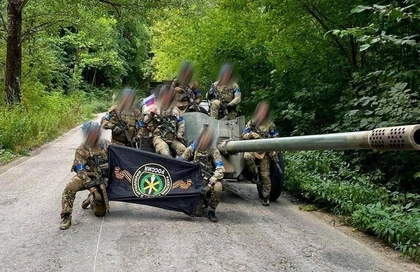In a May 3 interview with the Handelsblatt German-language business news outlet, CEO Armin Papperger reaffirmed earlier reports that Rheinmetall would have the capacity to manufacture at least 700,000 155mm artillery shells in 2024, “almost all of which will go to Ukraine.”
This quantity would be equivalent to more than a third of Kyiv’s annual needs at conservative consumption rates or less if the Armed Forces of Ukraine (AFU) attempts a major offensive. Russian rates of fire are currently five times higher than those of AFU forces.
JOIN US ON TELEGRAM
Follow our coverage of the war on the @Kyivpost_official.
Since Russia invaded Ukraine in February 2022, triggering the largest conventional conflict seen in Europe since 1945, Western governments supporting Ukraine have been slow to commit sufficient resources to the manufacture of war materiel at the scale needed.
Rheinmetall, working with Norwegian and US artillery manufacturers has been testing extended-range projectiles employing ramjet technology since the early 2020s.
In 2023 the US-Italian corporation Leonardo delivered small quantities of the Vulcano ramjet-assisted shell with a range of 50-75 kilometers (31-47 miles) – roughly twice the range of conventional rounds fired by most current Russian guns.


‘Enough of Fico, Glory to Ukraine’ – Ukraine at War Update for Dec. 24
Artillery users would value long-range shells that could predictably hit targets beyond the range of that of the enemy because it would reduce or even eliminate the enemy’s ability to hit back.
Papperger said that Rheinmetall would be able to deliver extended-range, ramjet-assisted 155mm artillery rounds capable of reaching the 100-kilometer (62-mile) range for testing during 2024, without specifying the end user.
Although hesitant at the outset of the war to offer Ukraine high-tech military assistance, Germany, led by Chancellor Olaf Scholtz had, by late 2023, reversed much of that policy.
Germany’s government has provided effective combat field-tested advanced artillery munitions in the past to Ukraine. This has included the SMArt 155mm shell, a projectile designed to fly out to extreme ranges and, using precision-guidance, release a pair of sub munitions to attack a tank’s thin roof armor.
Germany is currently Ukraine’s most important supplier of air defense systems, particularly the US Patriot and IRIS-T missile systems, and the Gepard autocannon anti-aircraft system.
German industry also is a major source for the AFU of artillery ammunition of all types, armored vehicles, and specialized combat vehicles.
According to Bundeswehr figures Germany, to date, has delivered or committed to provide Ukraine with the equivalent of $30.1 billion (€28 billion) in all types of material military assistance.
German industry is fully capable of increasing manufacturing output of advanced weaponry in the quantities needed, Papperger said, but unless the German government commits to new, major arms acquisition funding into the late 2020s, and signs up for continuing large-scale purchases of major weapons systems, then the emergency funding Berlin has earmarked to support Ukraine will run out by the end of 2026.
“If these [future capital-driven] €30 billion [$32.4 billion] are not invested, then the turnaround [commitment to re-armament and Russian deterrence] will fail, then it will be a flash in the pan,” Papperger said. “It makes no sense for me to set up a factory for a billion euros in which I could produce 10,000 tanks [yearly], but only 70 are required every year. Then I’ll be done with it in the second week of the year.”
The German defense company Hensoldt, an arms manufacturer specializing in air defense systems and military electronics, announced on Friday, in parallel with Papperger’s comments, that it had received orders to deliver six advanced TRML-4D air surveillance radars to Ukraine.
The radar system is a key element in Germany’s IRIS-T air defense system, which consists of a network of launchers, control vehicles, and tracking radars built around a ground-launched version of the well-proven Luftwaffe air-to-air missile, also called IRIS-T.
Ukrainian officials led by President Volodymyr Zelensky have praised IRIS-T as highly effective against Russian aircraft, missiles and drones.
AFU supplies of IRIS-T missiles ran short in the Fall of 2023 following intensified Russian missile raids on Ukrainian civilian infrastructure, for which deliveries of replacement IRIS-T missiles were unable to keep pace.

Hensoldt stated that it delivered eight radars to Ukraine in 2023 and, counting the latest eight-radar batch, will have delivered 27 TRML-4D radars by the end of 2024. Ukraine has yet to lose a single radar, the statement further claimed.
Hensold CEO Oliver Duerre stated: “Our radars are urgently needed by the Ukrainian air defenses and we are proud to be able to deliver all the systems this year. The feedback from our customers confirms how important the rapid availability of the radars is for the protection of their citizens.”
On April 29, the German government announced it was sending Ukraine the second of two advanced Skynex auto-cannon systems to help Kyiv bulk up its anti-drone defenses.
The Rheinmetall-built vehicle is equipped with a pair of cannon linked to advanced radars and data processing systems which can identify and destroy fast- low-flying objects like attack jets or cruise missiles.
From the AFU’s standpoint, Skynex is probably the best weapon available to counter the hundreds of Iranian Shahed drones Russia sends to attack civilian targets. However, a single Skynex has a range of 5 kilometers (3 miles) which allows it to cover about 75 square kilometers (47 square miles) while Ukraine’s air defenders have tens of thousands of square kilometers of air space to protect.
You can also highlight the text and press Ctrl + Enter






